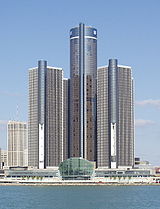- Opel Straight-6 engine
-
Opel Straight-6 Manufacturer Opel Also called Vauxhall Straight-6 Production 1968–1993 Successor 54° V6 Opel used the straight-6 engine configuration for many years, creating a major family of straight-6 engines for the 1970s and 1980s.
Contents
Predecessors
Opel used two straight-6 engines prior to the better-known modern family.
Moonlight
The Opel Moonlight roadster was the first Opel vehicle with a straight-6. It used a 1790 cc six in 1933. It was a 12-valve engine with a very-undersquare 65.0 mm (2.6 in) bore and 90.0 mm (3.5 in) stroke, typical for the time. This engine produced 33.5 PS (33 hp/25 kW) and 100 N·m (74 ft·lbf).
Kapitän
The 1956 Opel Kapitän was the next vehicle from the company with a straight-6 engine. This was a 2605 cc unit with 12 overhead valves. Bore and stroke were now oversquare for high power output at 85.0 mm (3.3 in) by 76.5 mm (3 in). A single Opel-designed carburetor and 7.8:1 compression yielded 91 PS (90 hp/67 kW) and 186 N·m (137 ft·lbf).
1968–1993
The modern (1968–1993) straight-6 was used in the largest Opel and Vauxhall cars. It was displaced by the Opel-designed 54° V6 in the mid 1990s.
These engines were cam in head cam chain driven, units with carburetors in the 1960s and 1970s, but was later fitted with Bosch fuel injection in the early 1980s.
A special 24v head design appeared on the Carlton/Omega and Senator in the beginning of the 1990s, this was later turbocharged by Lotus for the 1990s Lotus Omega/Carlton.2.5
The modern Opel straight-6 line began in 1968 with the 2.5 L (2490 cc) unit used in the Opel Commodore. Still a 12-valve engine, it had a very oversquare 87.0 mm (3.4 in) bore and 69.8 mm (2.7 in) stroke. 9.5:1 compression and a single carburettor produced 117 PS (115 hp/86 kW) and 174 N·m (128 ft·lbf), while 9.0:1 compression and dual carbs produced 132 PS (130 hp/97 kW) and 186 N·m (137 ft·lbf).
2.6
At the introduction of the 24v DOHC engine in Senator/Carlton/Omega, the 2.5 increased volume to 2.6 litres and with a reworked cylinderhead (still with twelve valves and pushrods) and RAM Induction it now produced 150 PS (110 kW; 148 hp). This engine was also fitted to southeast Asian export market versions of the Holden VP, VR, and VS Commodores between circa 1992 and 1997. These cars were usually labelled "Opel Calais".
2.8
The 2.8 was introduced in the first Commodore model.
The carburated version can also be found in the Monza and Senator,
wile the second Commodore also had a fuelinjected version produsing 150 PS (110 kW; 148 hp)3.0
The 3.0 L (2969 cc) version was introduced in 1977 alongside the fuel-injected 2.5.
The carburated version had 150 hp (112 kW), while in the more popular fuel injected version, the 3.0 produced 181 PS (178 hp/132 kW) and 248 N·m (183 ft·lbf) in the Opel Monza GSE and Opel Senator 3.0E.
Bore was up to 95.0 mm (3.7 in), but stroke remained at 69.8 mm (2.7 in).The 1986 Opel Omega 3000 / Vauxhall Carlton GSi introduced the latest version of the 3.0.
The injected engine produced 180 PS (177 hp/132 kW) and 240 N·m (177 ft·lbf).
Amongst the chages were larger valves and the change to Bosch Motronic.
It was later used in the Senator and Omega 3.0i.In 1989, a DOHC 24 valve version with a variable length intake manifold was introduced, with power increasing to 204 PS (150 kW) and 270 N·m.
The Omega Evo had a special Irmscher version of the 24v with an uprated head,
forged internals producing 230 PS (169 kW; 227 hp)3.6
Irmscher made a 12v 3.6 engine and fitted it to the Monza.
Later, they fitted it with the 24v DOHC head,
and put the engine in special Irmscher versions of the Omega A/Carlton and Senator B models.4.0
4.0 24v DOHC versions were made both by Irmscher and Mantzel.
The Irmscher version was put in the Omega Evo models, producing 272 PS (200 kW; 268 hp)Lotus 3.6 twin turbo
The Lotus Omega/Carlton introduced a stroked (to 85.0 mm (3.3 in)) version of the engine displacing 3615 cc. Lotus used twin Garrett T25 turbochargers and an air-to-water intercooler along with 8.2:1 compression and custom fuel injection. The turbos were arranged in parallel, each fed by and feeding three cylinders. The company reportedly experimented with a variety of forced induction schemes, including paired supercharging and turbocharging and sequential turbos, before settling on two small turbos for quick spool-up. The Lotus engine produced 382 PS (377 hp/281 kW) at 5200 rpm and 568 N·m (419 ft·lbf) at 4200 rpm.
See also
References
- "Lotus Carlton". LotusEspritWorld.com. March 5, 2006. http://www.lotusespritworld.com/LotusModels/LotusCarlton.html.
- "Lotus Carlton". Car and Driver (April 1991).
- "Opel Straight 6-cylinder cars". Carfolio.Com. March 5, 2006. http://www.carfolio.com/specifications/models/?man=4694&f=6c&f=ci.
Opel Current Opel
passenger carsCurrent Opel
commercial vehiclesHistoric and
discontinued modelsAdmiral • Arena • Ascona • Bedford Blitz • Blitz • Calibra • Campo • Chevette • Commodore • Diplomat • 5/12 PS "Puppchen" • 4/8 PS "Doktorwagen" • Frontera • GT • Kadett • Kapitän • Laubfrosch • Manta • Monterey • Monza • Olympia • Omega • Patentmotorwagen „System Lutzmann“ • P4 • RAK • RAK1 • RAK2 • Regent • Rekord • Senator • Signum • Sintra • Speedster • Super 6 • Tigra • 10/30 (10/35) PS • 12,3-Liter-Rennwagen • VectraMotor racing cars Concept cars Divisions and
subsidiariesOpel Eisenach GmbH • Opel Motoren Kaiserslautern GmbH • Opel Powertrain GmbH • Opel Performance Center GmbH • Opel Special Vehicles GmbHOther Founder: Adam Opel • Opel InternationalCategories:- Opel engines
Wikimedia Foundation. 2010.

